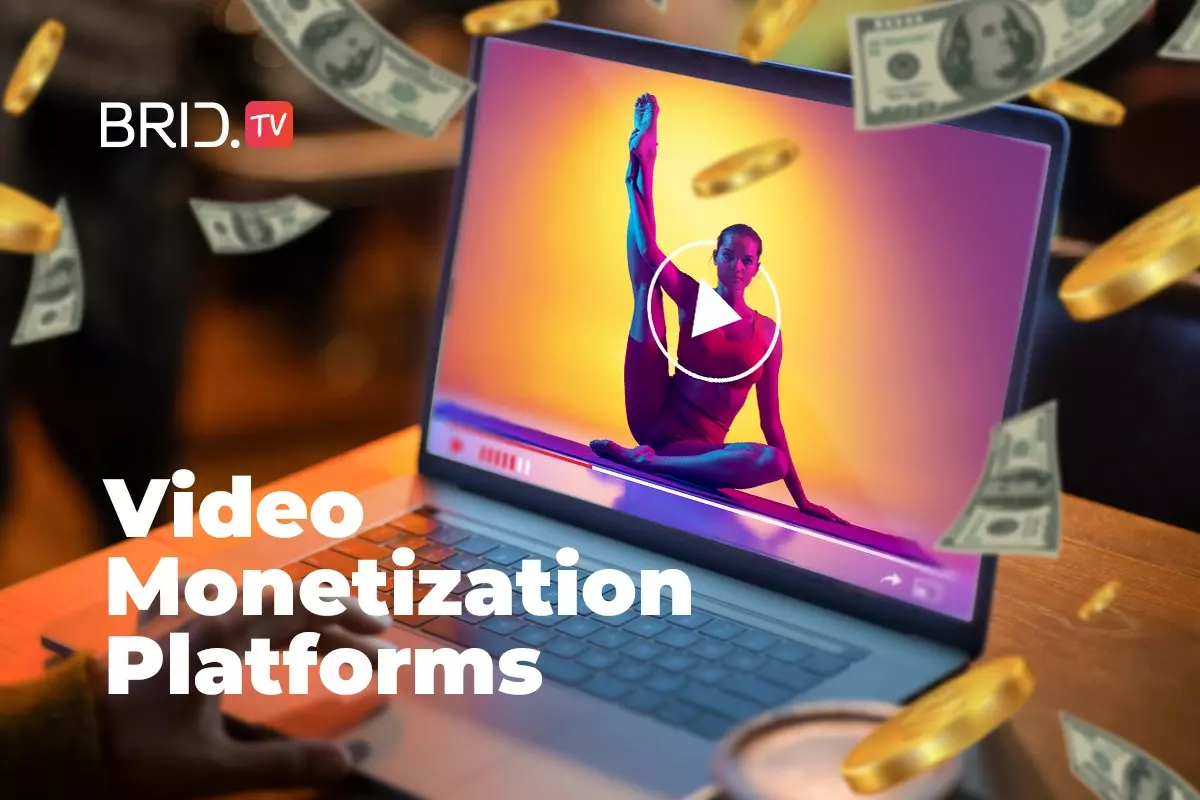Video monetization has been gaining popularity rapidly, and its future is looking promising. According to statistics, the video streaming app industry is projected to reach over $100 billion by 2026. With these numbers in mind, it is completely understandable that more publishers want their piece of that pie and are actively looking for video monetization platforms.
However, before you give over your revenue potential to just any vendor out there, it is important to decide how to monetize content and who to entrust with that process. We’re here to help you make these important decisions. Let’s first take a look at what video monetization is and how you can turn videos into a source of revenue. In case you’d rather just check out our list of top video monetization platforms, you can jump to that section from the table of contents below.
What Is Video Monetization?
Video monetization, put simply, is the process of generating revenue from online video content. Publishers can monetize their videos in various ways, such as subscriptions or ads. However, whichever video monetization model they choose, they will likely need a platform to help them get set up.
How Publishers Can Monetize Videos
We have already mentioned that there are several different ways publishers can monetize video content. Let’s take a closer look at what they are.
Through Affiliate Deals
Affiliate deals are direct deals struck between a publisher or creator and a brand. These deals grant the publisher a percentage of revenue or a fixed fee for each new client or purchase the brand gets through them. For example, a company might assign a creator an affiliate link. The viewers can use this link to access the brand’s website or even to get a discount. Each time a viewer uses the affiliate link to purchase goods, the publisher gets a cut.
This method of monetization has its fair share of advantages. For example, publishers get to decide what kinds of brands they associate with, and there really is no upper limit to how much they can earn. However, affiliate marketing is not the most stable stream of income. On top of this, instead of focusing on building their own brand and reputation, affiliate publishers have to do so for another business.
Paywall Content
Paywalled content is a method of video monetization known in industry circles as transaction-based video on demand (TVOD). Put simply, this entails the act of selling access to individual pieces of content, either indefinitely, for a limited period, or for a limited number of views. In other words, if a user wants to view your video, they will have to carry out a one-time transaction.
TVOD is a great monetization method for online courses or premium content (such as newly released movies, for example). However, a major drawback of TVOD is that it lacks the ability to build a relationship between a publisher and their audience, as a user may only purchase a piece of content once, and then never come back. This, at the very least, results in unpredictable monthly earnings for the publisher.
In the case of TVOD, it is essential that publishers have access to high-end DRM technology. This way, they can prevent paying customers from illegally downloading, editing, and/or redistributing content to others.
Creating a Premium Membership
Subscription-based video on demand (SVOD) relies on recurring membership payments from users. These are usually on a monthly basis, but they can be set for any predetermined period of time. SVOD is one of the most popular monetization models for OTT streaming services.
Once they subscribe, users can access content for a specified period and an unlimited number of views. Users can usually opt out at any time, upon which they lose access to the content. As with TVOD, having reliable DRM technology in place is paramount.
One of the biggest challenges of SVOD is consumer retention. That’s why this monetization model is a great option for publishers who regularly release new content.
Serving Video Ads
Ad-based video on demand, also known as AVOD, relies on serving advertisements within the video stream to monetize content. One of the biggest advantages of AVOD is that it allows publishers to offer their content to users for free while still generating revenue.
This monetization method is bound to attract a larger audience that wouldn’t be too eager to pay for access. On the other hand, it offers a less smooth viewing experience, as streams may be interrupted by ads.
Which Video Monetization Models Are Best?
Deciding on the right monetization model can make a world of difference for your video business. The right choice will depend on a number of factors, such as the size of your existing audience, the industry you’re in, how often you release new content, and so on.
For instance, affiliate deals are a good choice for influencers and content creators who already have an established relationship built on trust with their audience. Even then, it is better used as supplemental income than the main source of revenue.
On the other hand, TVOD is great for publishers with exclusive content, such as blockbuster movies. It is also a good choice for publishers who don’t release new content on a regular basis. However, for less-known content creators with a smaller audience, TVOD would not be the best choice.
SVOD is the go-to option for many streaming services, some of the biggest ones being Netflix and Hulu. This monetization model is best suited for publishers with regular new releases and shows that keep the audience coming back for more. As with TVOD, SVOD really only makes sense if the content is not available elsewhere for free.
Lastly, AVOD is a great choice for publishers with a growing or large and diverse audience, lower–quality content production, or shorter videos. However, even large streaming platforms such as Netflix have started integrating AVOD into their offer due to its power to attract new viewers.
Consider Hybrid Monetization
If you’re having trouble deciding on the right monetization method for your VOD business, we have great news — you don’t have to! The option to combine two or more methods for a single platform is always there, and it might not be a bad idea at all. For example, you can offer a free, ad-supported plan to new users or those who simply don’t want to pay for content but also leave the option of subscribing to your services for those who would rather not deal with ads.
Why You Should Choose a Premium Video Monetization Platform Over a Free One
Regardless of which monetization method you choose, you will need some sort of software solution to allow you to process transactions or serve ads. For example, if you’re planning to serve video ads, you will have to either join a video ad network or sign up for an online video platform that will take care of the process for you.
There are both free and premium monetization providers out there, so you might be wondering — why should I pay for a service I can get for free? The truth is that even free ad monetization platforms need to make money somehow, and usually, they do so by taking a percentage of the publisher’s revenue and maintaining full or partial control over the monetization process.
Let us take YouTube as an example. Many smaller content creators generate video ad revenue by allowing YouTube to serve advertisements on their videos. However, the platform itself takes a considerable part of the revenue. This is one of the reasons many content creators resort to affiliate deals to supplement their income.
What’s more, YouTube maintains full control over what kinds of ads show up on publishers’ videos, their floor CPMs, and so on. In addition, free platforms often claim the rights to all the content uploaded on their websites, meaning that content creators don’t really own their content anymore. And lastly, free video platforms often have insufficient content security in place.
If you’re serious about starting and growing a video business, finding alternatives to YouTube video monetization might be worth the investment. Sure, you will have higher expenses, but your potential revenue will be entirely in your control.
12 Top Video Monetization Platforms for Making Money in 2023
Deciding how to turn your content into a source of income is only the first step of the monetization process. Now, it is time to choose the right platform to help you do so. Let’s take a look at some of the best video monetization platforms on the market.
1. Brid.TV
| Monetization Model | Key Monetization Features | Pricing | Free Trial |
|---|---|---|---|
| AVOD | Video and display ads Various video ad formats Video header bidding Contextual targeting Engaging ad units Ad podding Ad analytics Header bidding analytics |
Starts at $24.99/month | Yes |
Brid.TV is a robust online video platform and monetization provider tailored to medium and large publishers. It offers an array of useful features that cover all major aspects of running an online video business.
For instance, unlimited private video hosting is available to all of Brid.TV’s publishers. The platform also has a lightweight, low-latency, and fully brandable HTML5 player with adaptive bitrate streaming capabilities. Some other features Brid.TV’s publishers can count on are in-depth video analytics, live streaming support, audience engagement tools, and more.
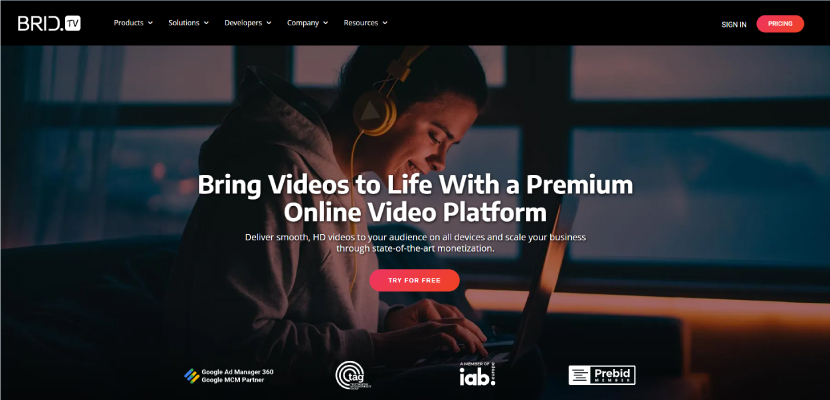
Monetization Overview
Brid.TV allows publishers to monetize their video content by serving video ads. It supports a wide range of video ad formats, including both instream and outstream video ads.
Brid.TV relies on programmatic video advertising technology and header bidding, which allow publishers to put video ads on their websites and generate revenue with minimal effort. Header bidding analytics and ad analytics are also available.
The platform has an array of engaging ad units designed to enhance the user experience and maximize the effectiveness of ads. For example, there is the sticky ad unit, which remains on the user’s screen even as they scroll. Some other perks of monetizing with Brid.TV include ad podding, VAST and VPAID compatibility, contextual targeting, dynamic ad insertion, and more.
Brid.TV even provides its publishers with premium ad demand directly through its proprietary Marketplace. This solution comes with some amazing perks, such as a dedicated ad ops team that will help you set up and optimize campaigns. Brid.TV Marketplace is also a Google MCM partner, meaning that its publishers get ad demand from Google ADX, even if they don’t satisfy Google’s high eligibility requirements.
Pros:
- Robust online video platform
- Video and display advertising support
- Programmatic advertising and video header bidding
- Header bidding and ad analytics
- An array of ad formats and units available
- Brid.TV Marketplace with access to premium ad demand
Cons:
- No built-in SVOD or TVOD
- Advanced advertising features only available with the Premium plan
Pricing Overview
Brid.TV has three membership plans. Here’s a quick overview of each one:
- Essential ($24.99/month) — Instream ads, VAST/VPAID compatibility, ad analytics, access to Brid.TV Marketplace, video encoding and unlimited storage, basic player customization, APIs and SDKs, and more.
- Business ($89.99/month) — Everything in Essential + outstream ads, ad scheduling, Prebid with analytics, SpotX integration, ad geo-targeting, advanced encoding, adaptive HLS streaming, AI content matching, full player customization, player analytics, and more.
- Premium (custom) — A customizable plan tailored to the needs and requirements of your video business.
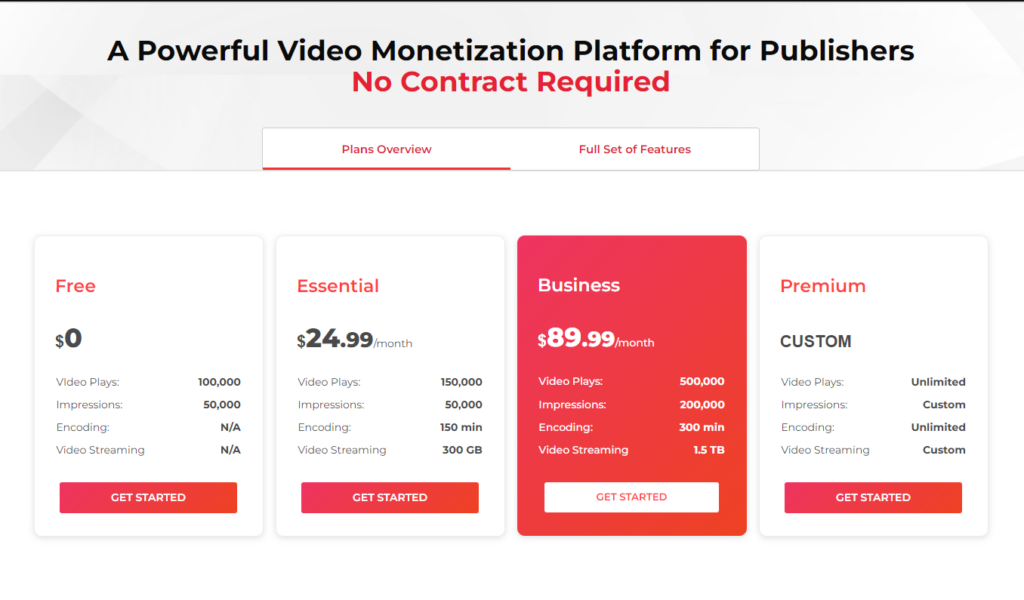
2. Uscreen
| Monetization Model | Key Monetization Features | Pricing | Free Trial |
|---|---|---|---|
| SVOD, TVOD | Subscription tiers Free trials Rentals Lifetime access Pay-per-view Various payment options |
Starts at $79/month | Yes |
Uscreen is a video management and monetization platform with an emphasis on providing OTT support. It allows publishers to easily launch mobile and CTV apps, and it comes with a reliable video player, marketing and analytics tools, and, of course, monetization support.
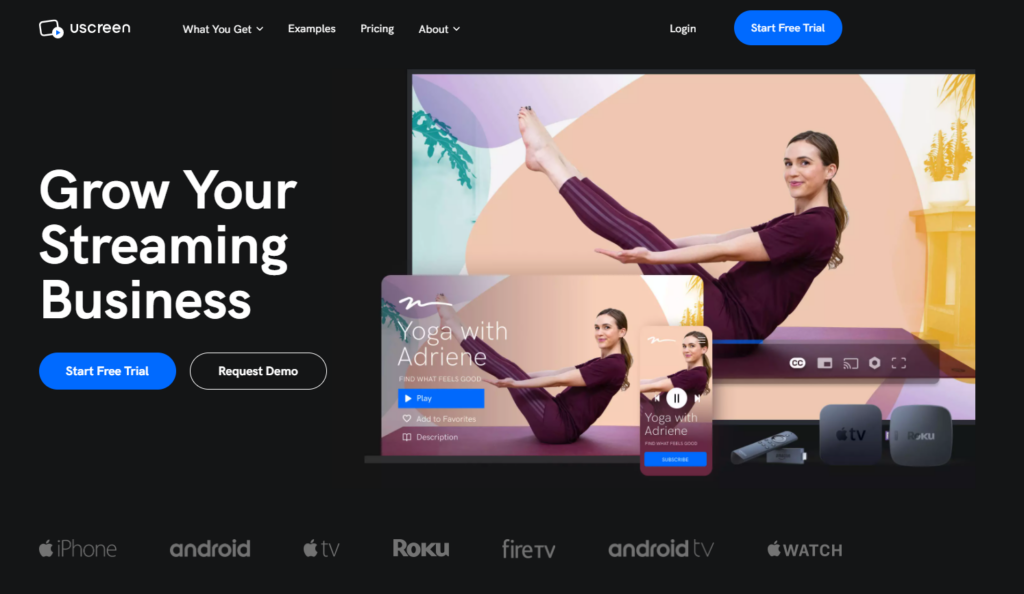
Monetization Overview
Uscreen allows publishers to monetize videos in two ways — by offering memberships (SVOD) and through one-time transactions (TVOD).
When it comes to transaction-based monetization, Uscreen offers several options. First, there is the pay-per-view model, where users have to pay a small fee every time they want to access a piece of content. Rentals are another option, and they provide time-limited access to a piece of content without a limitation on the number of views. Lastly, publishers can sell content bundles or offer lifetime access to their videos for a one-time fee.
The other monetization option, SVOD, works on the basis of recurring payments. Publishers can set up multi-tier subscription plans (i.e., plans that offer varying levels of content availability at varying prices) and even offer a time-limited free trial.
Uscreen’s payment processing solution accepts all major credit and debit cards, PayPal payments, and international transactions. However, the platform charges publishers a recurring monthly or annual fee, as well as a recurring fee for each subscriber and a one-time fee for individual transactions.
Pros:
- Comprehensive OTT platform
- Extensive TVOD support
- Extensive SVOD support
- Accepts most payment methods
- Instant payout available
Cons:
- No built-in AVOD support
- Platform takes a cut from each subscription
- Platform takes a cut from each transaction
- OTT support available for premium users only
Pricing Overview
Uscreen’s solutions come in three different payment plans:
- Basic ($79/month, $0.50/subscriber/month, 5% per transaction) — Secure video player, video hosting and unlimited encoding, advanced audience analytics, full monetization support, and more.
- Growth ($159/month, $0.50/subscriber/month, 5% per transaction) — Everything in Basic + upsells, geo-blocking, custom checkout fields, e-commerce integration, and more.
- Plus (custom base price, $0.50/subscriber/month, 5% per transaction) — A customizable plan with OTT support, live streaming, and more.
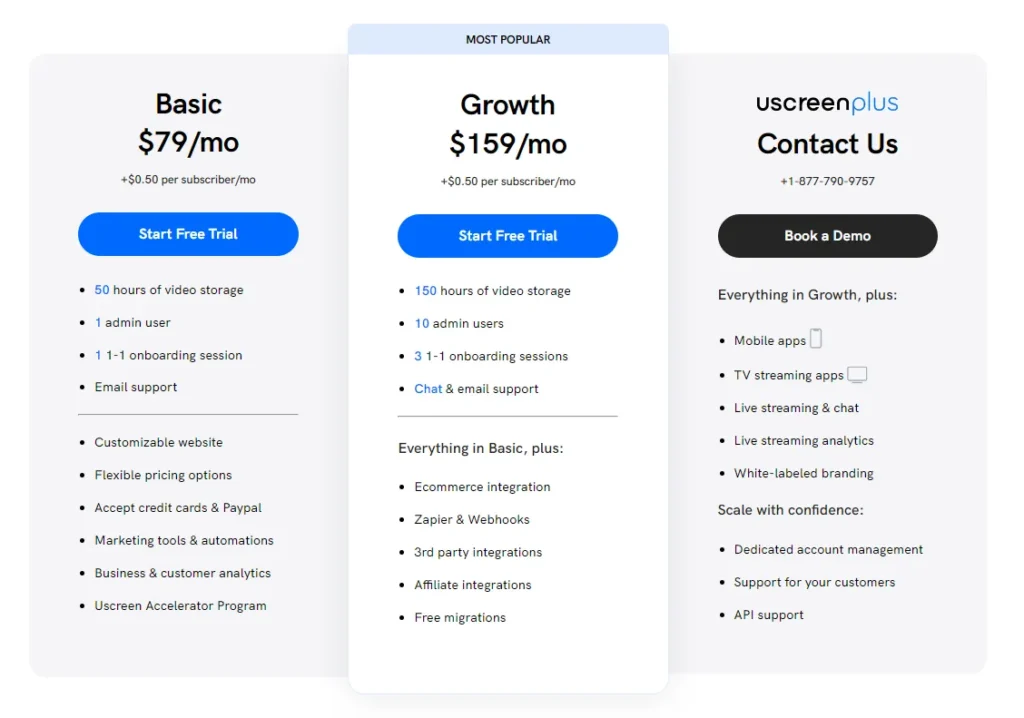
3. Brightcove
| Monetization Model | Key Monetization Features | Pricing | Free Trial |
|---|---|---|---|
| AVOD, SVOD, TVOD | Ad network integrations Programmatic ad technology Various ad formats |
N/A | Yes |
Brightcove is an enterprise video platform with comprehensive features and solutions tailored to large publishers. It offers secure video hosting, an array of video management and distribution tools, live event streaming support, video marketing toolkits, corporate communication features, and so much more.
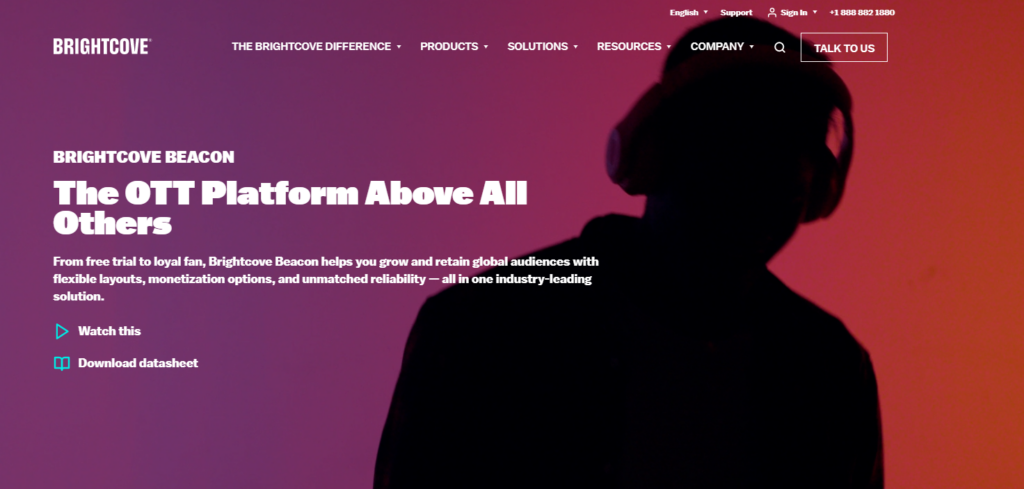
Monetization Overview
Brightcove is likely one of the most comprehensive video monetization platforms out there. It supports all three major monetization models — AVOD, SVOD, and TVOD.
Brightcove’s solutions come with built-in integrations with some of the largest ad networks, providing publishers with access to high-quality demand. The main selling point of Brightcove’s AVOD is instream ads, including pre-roll, mid-roll, and post-roll ads. Another handy format is companion ads — synchronized instream and banner ads. The platform relies on programmatic video advertising.
Brightcove also offers subscription- and transaction-based monetization options, but they have provided very little information concerning the details of these solutions publicly. Instead, Brightcove urges potential customers to contact their sales team to find out more.
Pros:
- All three major monetization models supported
- Comprehensive enterprise-level video platform
- Excellent content privacy and security
- Integration with an array of ad networks
- Innovative ad formats
Cons:
- Non-transparent pricing
- Non-transparent details on various services
- Not suitable for smaller streamers and publishers
- Dedicated support reserved for higher-priced tiers
Pricing Overview
Unfortunately, Brightcove doesn’t disclose its pricing publicly. If you’re interested to find out how much the platform’s services would cost you, you will have to contact their customer support.
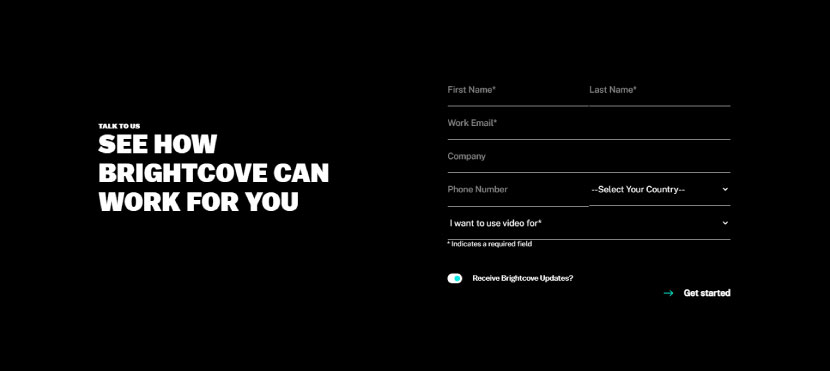
4. Dacast
| Monetization Model | Key Monetization Features | Pricing | Free Trial |
|---|---|---|---|
| TVOD, SVOD, AVOD | Secure paywall 135 currencies supported Free trials Promo codes Instream ads Promo videos |
Starts at $39/month | Yes |
Dacast is a video streaming platform with support for VOD, live streaming, and OTT broadcasting. It comes with a comprehensive video content management system and video hosting services.
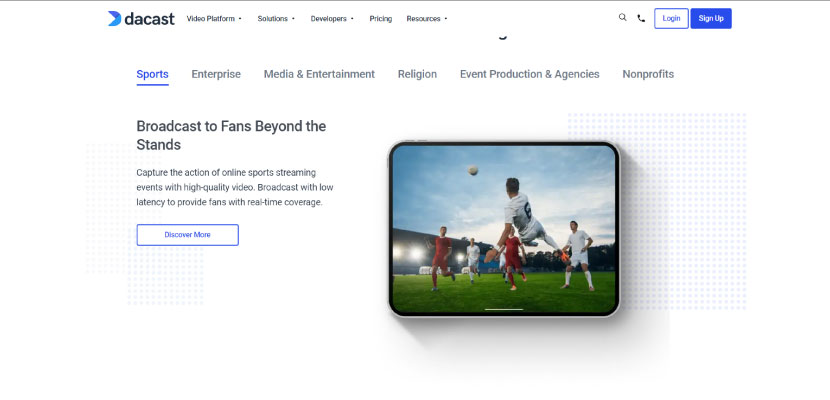
Monetization Overview
Dacast supports all three major monetization models. However, its AVOD support is quite limited. Dacast’s player is compatible with VAST, VPAID, and VMAP ad tags, and it can serve pre-roll, mid-roll, and post-roll video ads. Unfortunately, the platform doesn’t offer any ad demand, so publishers need to integrate it with their third-party ad network.
Support for transaction- and subscription-based monetization is quite more extensive. Publishers can easily set up weekly and monthly subscription plans. Dacast’s integrated paywall solution supports over a hundred world currencies, and it automatically converts prices for the end user.
Publishers who opt to monetize their content through Dacast’s paywall can even set up discount codes and free trials, serve video teasers on the paywall page to attract more subscribers, and more.
Pros:
- SVOD, TVOD, and AVOD support
- Secure paywall with 100+ currencies
- Comprehensice online video platform
- Free trials and promo codes available
- Innovative audience engagement features
Cons:
- Limited ad formats available
- No built-in ad demand
- Extra charge for each subscriber and transaction
- Monetization not available with the Starter plan
Pricing Overview
Dacast has four pricing plans for its services:
- Starter ($39/month) — Video hosting, live streaming support, customizable HTML5 player, real-time analytics, and more.
- Event ($63/month + 9.9% commission + $0.40 per purchase) — Everything in Starter + paywall integration, ad-based monetization, and more.
- Scale ($188/month + 9.9% commission + $0.40 per purchase) — Everything in Event + DRM for VOD, phone support, and more.
- Custom (custom pricing) — A fully customizable plan tailored to your needs.
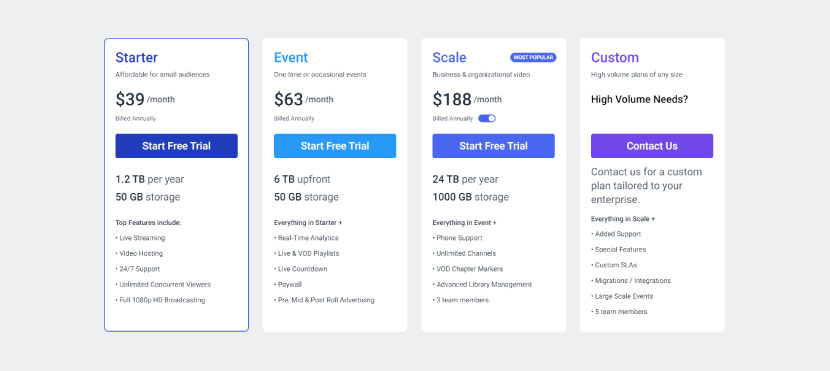
5. JW Player
| Monetization Model | Key Monetization Features | Pricing | Free Trial |
|---|---|---|---|
| AVOD | Integration with all ad networks Premium ad-demand Video header bidding Cross-device ad serving Innovative ad formats |
Custom | Yes |
JW Player was one of the first online video solutions on the internet, and it has retained its exclusive status to this day. What started as a web player back in 2004 has grown to be one of the largest video management and monetization solutions on the market.
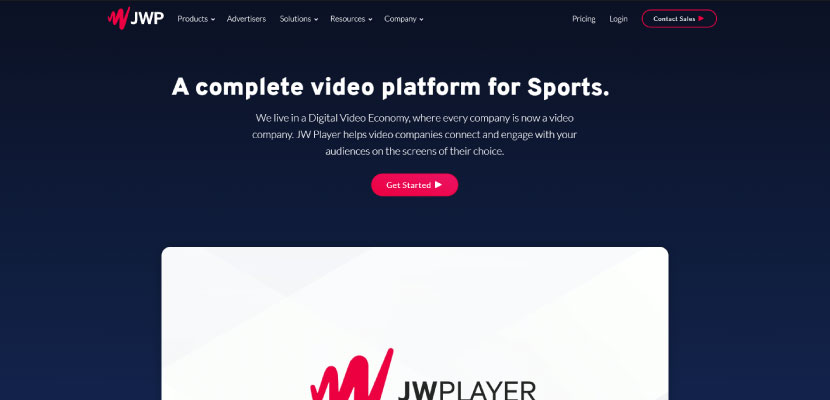
Monetization Overview
JW Player relies on advertising to help its publishers monetize video content. The platform integrates with all video ad servers, SSPs, and ad networks, and it provides high-quality ad demand from exchanges such as SpotX, Google ADX, and FreeWheel. It uses state-of-the-art video header bidding technology powered by Prebid.
JW Player makes it possible for publishers to serve video ads on an array of devices, including CTVs, mobile apps, desktop apps, and the web. In addition, it is compatible with all the major operating systems and browsers. Some great perks that come with JW Player ad serving include ad scheduling capabilities, ad podding, companion (synchronized) ads, and more.
Pros:
- Fully fledged OVP
- Extensive AVOD support
- Premium ad demand from major exchanges
- Prebid-powered video header bidding
- Wide array of ad formats available
- Cross-device compatibility
Cons:
- No support for SVOD and TVOD
- Non-transparent pricing
- Not beginner-friendly
Pricing Overview
JW Player doesn’t have pre-defined pricing tiers. Instead, it offers a custom-tailored plan to each publisher. However, this also means that, to open an account, publishers need to contact the platform’s customer support team.
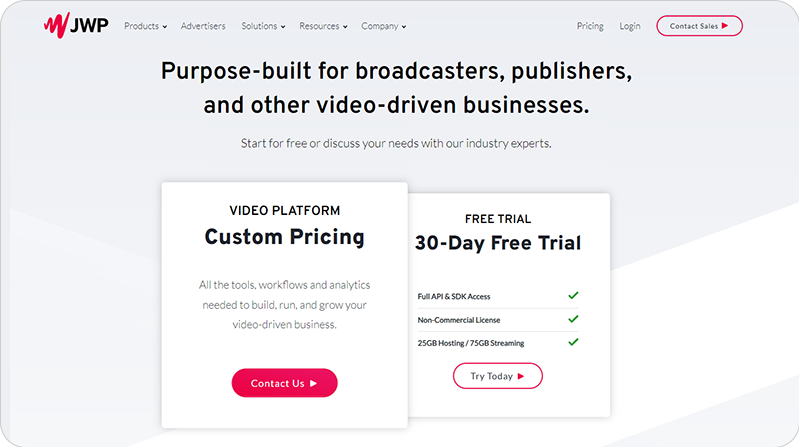
6. Vimeo
| Monetization Model | Key Monetization Features | Pricing | Free Trial |
|---|---|---|---|
| SVOD, TVOD, AVOD | Cross-device OTT monetization 100+ currencies supported Free trials and free-to-view content Audience retention features |
Custom | Yes |
Vimeo is an all-in-one video platform and one of the most popular video solutions on the market right now. It is tailored to publishers of all sizes, as it offers highly scalable plans. It comes with all the typical features of a video platform, such as hosting, encoding, management, and OTT monetization.
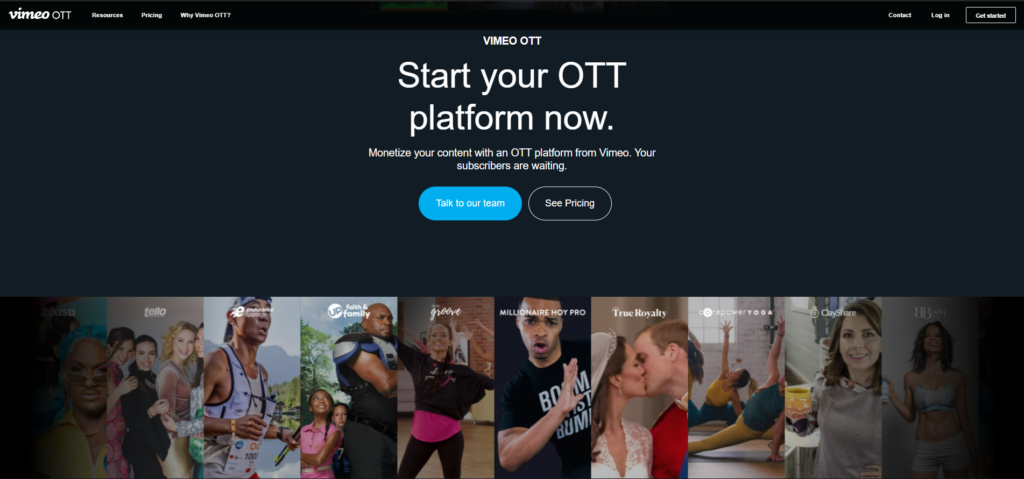
Monetization Overview
Vimeo allows publishers to monetize by selling their content on a transaction or subscription basis. Publishers can sell access to live streams, be they sporting events, master classes, art performances, or any other type of online event. They can also sell access to on-demand content through their own mobile, desktop, or CTV app.
In addition to individual transactions, publishers can set up subscription plans for users interested in receiving new content on a regular basis. Vimeo’s paywall supports 100+ currencies and allows publishers to accept payments from anywhere in the world.
Publishers can also offer their audience free trials and limited free-to-view content to attract new viewers. Discount coupons, gift subscriptions, and promotions are also available.
Vimeo also supports AVOD-based monetization, but this option is reserved for high-volume Enterprise users. What’s more, the platform doesn’t publicly disclose details concerning this monetization method.
Pros:
- All-in-one video platform
- Extensive TVOD support for live and on-demand content
- SVOD support with various subscription tiers
- Viewer generation and retention features
- Cross-device support
Cons:
- AVOD only available for Enterprise users
- Pricing plans come with fine print
- Live streaming only available with higher plans
- Monetization requires the OTT platform
- Extra charge for each subscriber and transaction
Pricing Overview
Since Vimeo only lets publishers monetize content if they use the Vimeo OTT platform, we’ll take a quick look at its OTT pricing plans:
- Starter ($0/month + $1/subscriber/month + $10 per transaction + upload fees) — Web-only OTT service, SVOD and TVOD capabilities, e-mail customer support.
- Enterprise (custom pricing with volume-based discounts) — Everything in Starter + support for iOS, tvOS, Android, Fire, Roku, and other operating systems, user registration, AVOD, live events with monetization, customer and viewer support, custom analytics, DRM, and more.
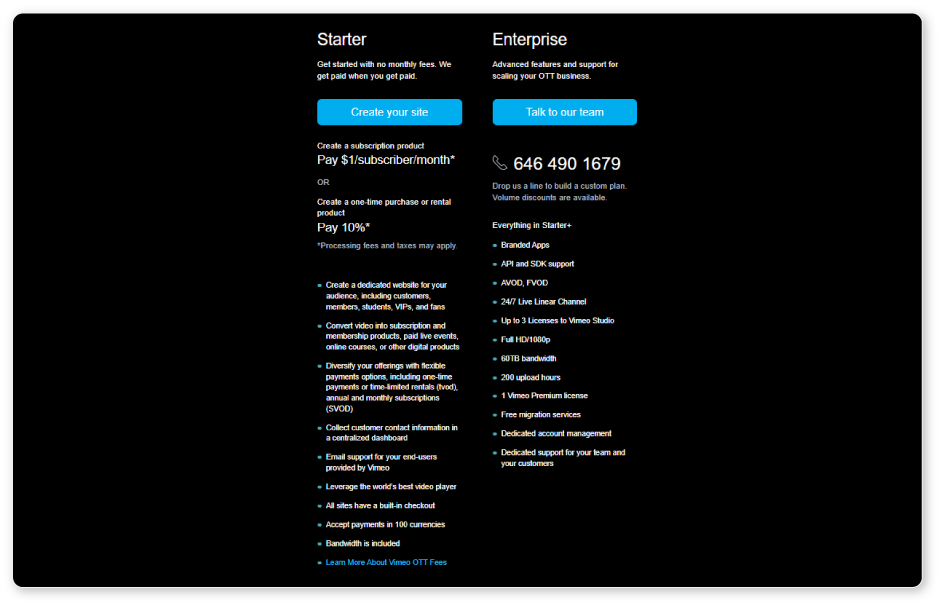
7. Muvi
| Monetization Model | Key Monetization Features | Pricing | Free Trial |
|---|---|---|---|
| SVOD, TVOD, AVOD | Instream video ads Integrations with ad servers Monthly, quarterly, and yearly subscriptions Recurring payments Various currencies and Bitcoin payments Automated recurring payments Shared User ID blocking |
Starts at $399/month | Yes |
Muvi is a robust, enterprise-level OTT platform that comes with a complete, ready-made infrastructure for large broadcasters and publishers. It even comes with features for audio streaming platforms for music, audiobooks, or podcasts.
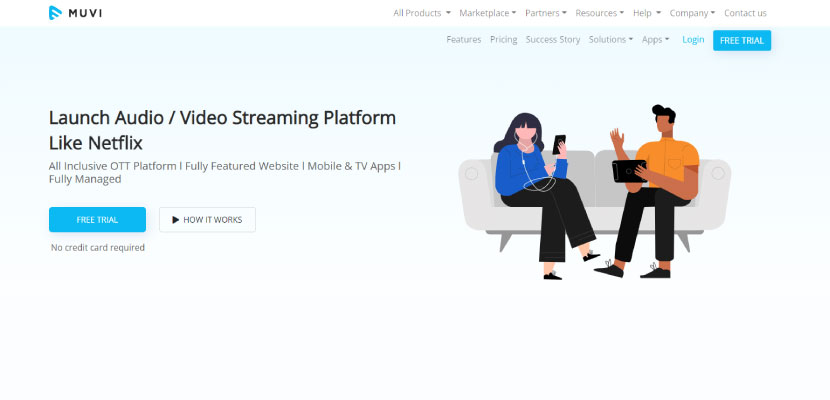
Monetization Overview
Muvi supports monetization through subscriptions, transactions, and advertisements. Ad-supported monetization comes with integrations with major ad servers, but it also supports third-party integrations for publishers who already have a server. Muvi’s player is compatible with VAST and VPAID ad tags, and it can serve all types of instream ads.
Publishers who decide to go for subscription-based monetization can create tiered plans for their audience and charge a monthly, quarterly, or annual subscription fee. They can even enable automated recurring charges to help their viewers stay on track with payments.
TVOD and pay-per-view monetization models come with extensive support too. Here, publishers can create bundles, and they can even set up different bundle pricing for subscribers and non-subscribers. Content pre-ordering is another handy feature that will generate additional revenue. Lastly, Muvi has set up technology that prevents multiple users from sharing a single User ID, saving its publishers from considerable revenue losses.
A great thing about partnering with Muvi is that it doesn’t take a single dime of publishers’ revenue. In addition to this, the platform’s payment processing system accepts a long list of currencies. In fact, publishers can even accept Bitcoin payments.
Pros:
- A robust, all-in-one OTT platform
- TVOD, SVOD, AVOD monetization support
- Reliable, secure payment processing system
- No revenue sharing
- Cross-device support
Cons:
- One of the most expensive platforms on the market
- Poses a high learning curve
- Pricing not entirely transparent
- Not optimal for small or medium publishers
Pricing Overview
Muvi offers its services at four different pricing plans, all of which also come with a free trial:
- Standard ($399/month + $299/month/app) — Video hosting and encoding, monetization engine for TVOD, SVOD, and AVOD, e-mail and ticket-based customer support;
- Professional ($1499/month + $499/month/app) — Everything in Standard + DRM, own CDN, AI-powered recommendations, SLA support;
- Enterprise ($3900/month + $499/month/app) — Everything in Professional + dedicated hosting server, staging environment, stress and security tests, phone support, dedicated account manager;
- Ultimate (N/A) — Everything in Enterprise + premium consulting services, on-demand support.

8. Connatix
| Monetization Model | Key Monetization Features | Pricing | Free Trial |
|---|---|---|---|
| AVOD | Integrated ad demand sources Ad quality control VAST/VPAID support Smart server bidding |
N/A | Yes |
Connatix is a growing video management platform with a focus on digital video advertising services. It comes with a fully-fledged OVP, customizable, lightweight video player, video hosting, an array of content management tools, and more.
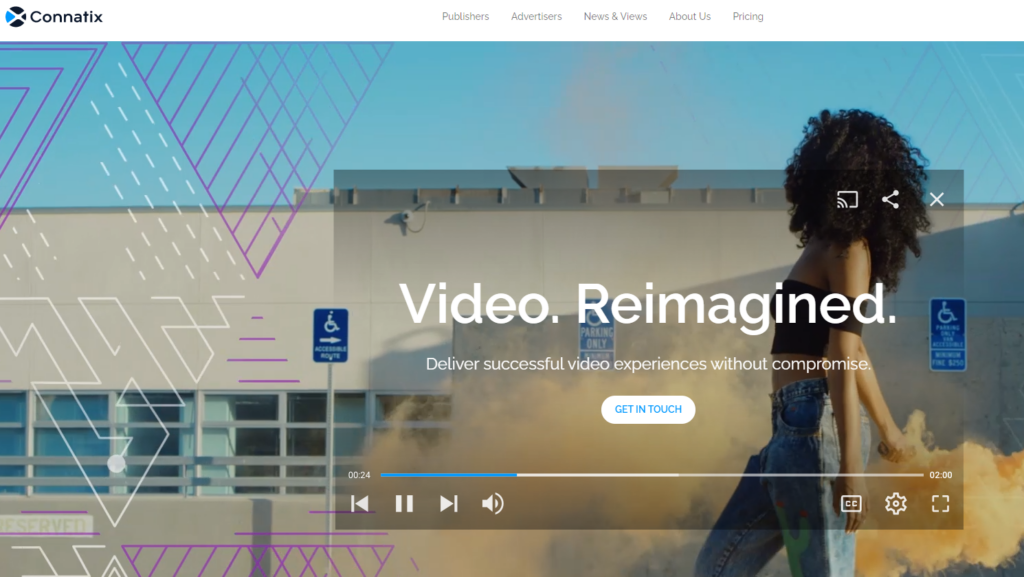
Monetization Overview
Connatix focuses on ad-based monetization capabilities. It relies on Prebid-powered real-time bidding to allow publishers to sell ad inventory. The platform uses contextual video advertising to maximize the performance of ads and, by extension, increase ad yield.
Connatix comes with ad server and ad exchange integrations, making publishers’ lives a lot easier. The platform’s player is VAST/VPAID compatible. Some other great features offered by Connatix include bot traffic detection and filtering, ad scheduling, direct deals and PMP support, and extensive analytics and reports.
Pros:
- Easy-to-use OVP
- Prebid-powered bidding
- Ad server and exchange integrations
- Bot traffic filtering
- Direct deals and PMP support
Cons:
- No support for SVOD or TVOD
- Non-transparent pricing system
- Advanced features reserved for the Enterprise plan
- Not as robust as some other alternatives
Pricing Overview
Connatix has four basic pricing tiers — one of which is ad-supported and comes at no cost to the publisher, while the rest have non-disclosed fixed prices:
- Ad-Supported Enterprise (revenue sharing) — Video player, VOD and live streaming, full advertising support, cross-device support, video CMS, and more.
- Essentials (N/A) — Video player, video CMS, audience engagement features, access to Connatix ad demand, analytics and reporting, and more.
- Premium (N/A) — Everything in Essentials + ad scheduling, customizable JS API, full third-party integrations, web and SDK targeting, Prebid, dedicated account management team, and more;
- Enterprise (N/A) — Everything in Premium + automated A/B testing, live streaming support, outstream ads, iOS and Android SDKs, Connatix AI Tech Lab, smart server bidding, contextual targeting, bot traffic filtering, direct deals and PMP support, and more.
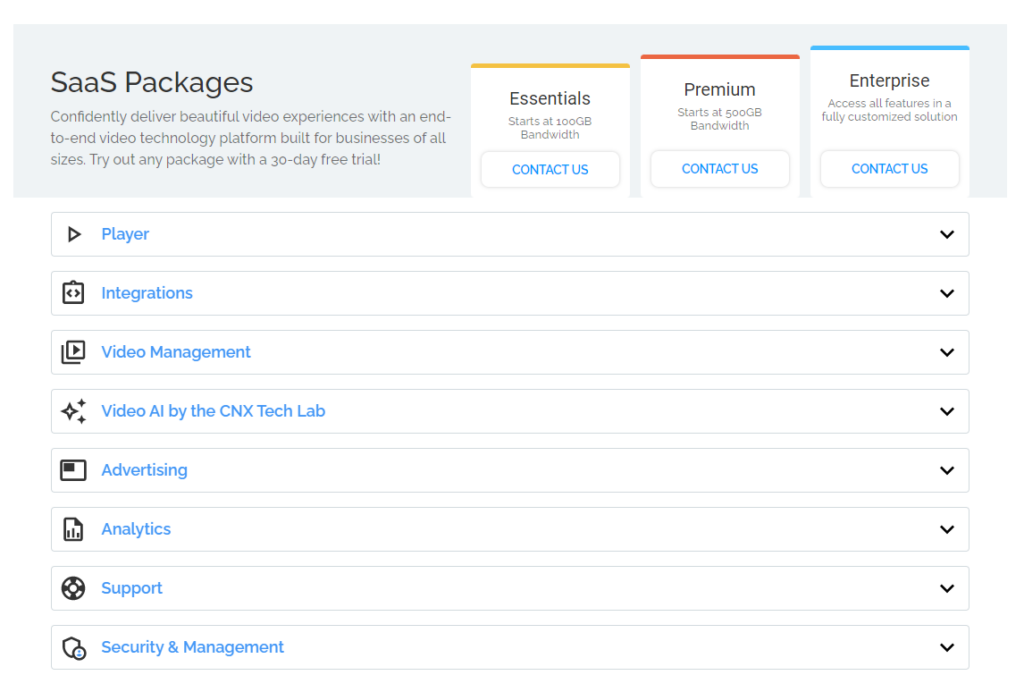
9. CONTUS VPlayed
| Monetization Model | Key Monetization Features | Pricing | Free Trial |
|---|---|---|---|
| SVOD, TVOD, AVOD | Flexible subscription plans Multi-currency paywall PPV, time-limited, and lifetime access Server-side and client-side ad insertion Third-party ad vendor integrations |
Custom | No |
VPlayed by CONTUS is an online video and OTT monetization platform that has been around since 2008. It offers top-notch products in the domains of OTT services, video on demand, audio streaming, online video hosting and management, and live streaming and broadcasting.
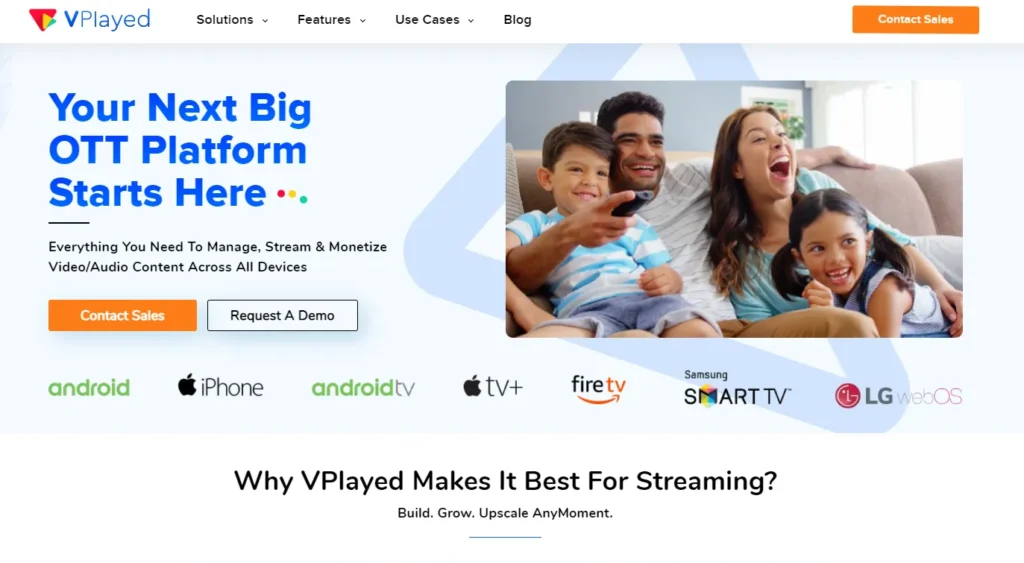
Monetization Overview
CONTUS VPlayed offers a wide array of monetization options to its publishers and broadcasters. With subscription-based monetization, VPlayed’s users can create flexible subscription tiers, both for live and on-demand content. They can offer their viewers free trials and discount coupons, set up recurring payments, and receive notifications for failed transactions.
Publishers who opt for TVOD can sell single and multi-part content, time-restricted or lifetime access, and pay-per-view plans. They can also offer existing subscribers discounted per-item prices for premium content and accept payments in various currencies.
Lastly, VPlayed’s publishers can opt to monetize videos through advertising. The platform supports both client-side and server-side ad insertion. In addition, a wide array of ad formats are available, including both instream and outstream video ads, interactive and companion ads, ad overlays, and more.
However, VPlayed doesn’t have existing ad demand. Still, it supports third-party integrations with some of the largest ad exchanges and networks, including OpenX, Verizon Media, AdGear, and more.
Pros:
- Fully-fledged OTT platform
- An array of SVOD capabilities
- Extensive TVOD support with various plans
- Multi-currency secure paywall
- AVOD support available
Cons:
- No built-in ad demand
- Non-transparent pricing
- Monetization requires an OTT platform
- Limited customer support
Pricing Overview
CONTUS VPlayed hasn’t made its pricing system publicly available. They create a custom plan for each client, so publishers who want to work with them should contact their sales team directly.
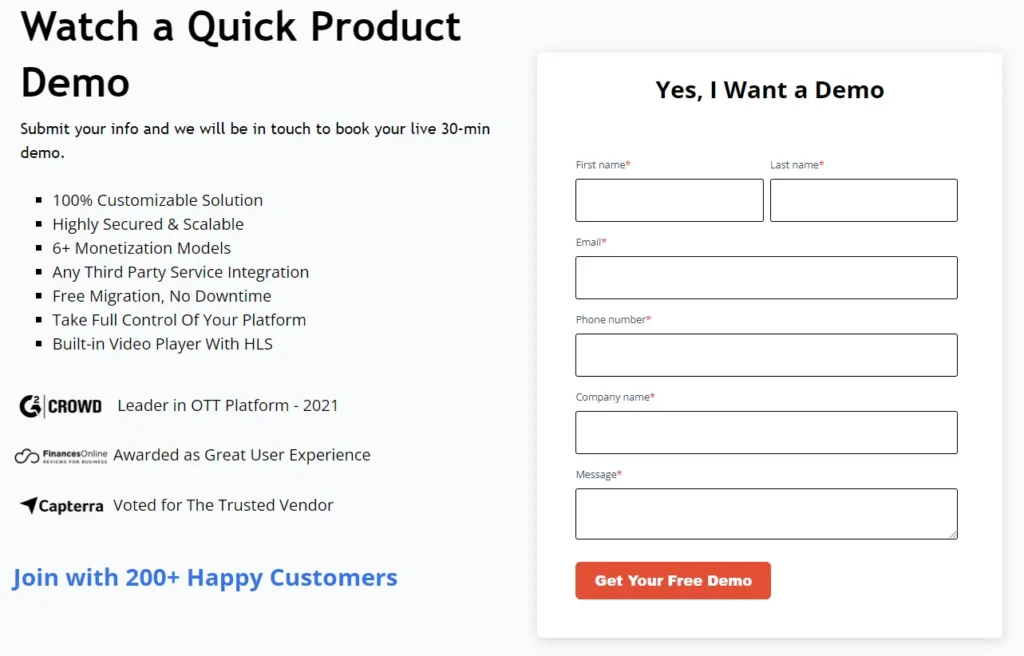
10. Flowplayer
| Monetization Model | Key Monetization Features | Pricing | Free Trial |
|---|---|---|---|
| AVOD | VAST, VPAID, and VMAP compatible Third-party ad vendor integrations Detailed ad analytics TVOD and SVOD third-party integrations |
Starts at $49/month | Yes |
Flowplayer started off as a feature-rich online player but has since expanded to offer an array of video-focused services, from hosting to monetization and management. It is one of the most popular video solutions on the market right now.
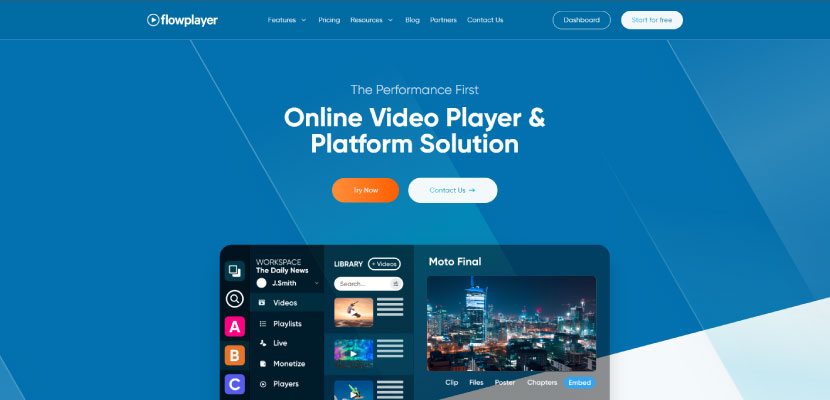
Monetization Overview
Flowplayer’s monetization features focus on video advertising. The player supports both client-side and server-side ad insertion, and it is compatible with VAST, VPAID, and VMAP ad standards.
Flowplayer has no built-in ad demand, but it allows publishers to integrate any third-party advertising network, server, or exchange. The platform also offers detailed advertising analytics and reports that allow publishers to optimize creatives and maximize ad yield.
While Flowplayer itself doesn’t offer TVOD and SVOD, it does allow third-party paywall integrations. This way, it allows publishers to open up alternative revenue streams. For this purpose, Flowplayer also comes with handy features such as DRM encryption, content-sharing prevention, access management toolkits, and more.
Pros:
- VAST, VPAID, and VMAP compatible player
- Third-party ad vendor integrations
- Extensive content protection tools
- Detailed, actionable ad analytics
- Third-party integrations for SVOD and TVOD
Cons:
- No built-in support for SVOD and TVOD
- Live streaming only available with the Enterprise plan
- Limited customer support for lower-tiered plans
- DRM only available with the Enterprise plan
Pricing Overview
Flowplayer does have a free plan, but it comes with very limited features and capabilities. For instance, free plan users only get one minute of encoding per upload, with a maximum of 60 uploads. They also have only 25GB of storage available with no option to purchase additional space.
Aside from the free plan, Flowplayer has two paid plans:
- Starter ($49/month) — White-label HTML5 player, real-time analytics, advertising capabilities, self-service demos and knowledge base.
- Enterprise (custom) — A customizable plan tailored to your needs, with optional features such as live streaming with analytics, DRM, and paywall integrations.
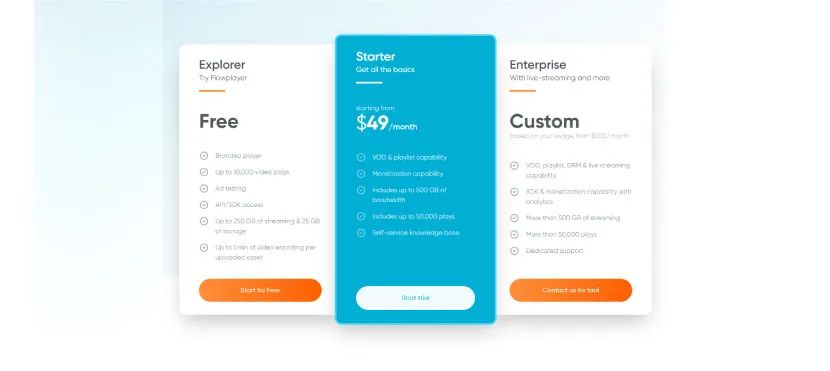
11. IBM Cloud Video
| Monetization Model | Key Monetization Features | Pricing | Free Trial |
|---|---|---|---|
| SVOD, TVOD, AVOD | Cleeng integration for paywall support Cross-device support Pay-per-view |
N/A | Yes |
IBM Cloud Video, formerly known as Ustream, is an enterprise-level video and OTT platform. It offers high-end solutions for businesses of various sizes, from small-time publishers with limited content to corporate-level clients with high-volume needs.

Monetization Overview
IBM Cloud Video is not the most transparent about the precise monetization solutions it offers publishers. The platform’s users can leverage subscriptions, transactions, and advertising to generate revenue from their OTT platforms or video websites. However, IBM urges potential clients to contact their sales team in order to find out more about the available monetization options.
Pros:
- Robust video platform
- Great scalability
- Cross-device support
- TVOD, AVOD, SVOD-compatible
- Very high level of content security
Cons:
- Non-transparent pricing
- Non-transparent services
- HD streaming comes at an extra cost
- Limited storage and streaming hours
Pricing Overview
IBM Cloud Video has four pricing plans, but the cost of those plans is not publicly available:
- Silver (N/A) — For small businesses; 100 viewer hours, 1 TB storage, 5 channels.
- Gold (N/A) — For medium-sized businesses; 2000 viewer hours, 2 TB storage, 10 channels.
- Platinum (N/A) — For frequent streamers; 5000 viewer hours, 5 TB storage, 20 channels.
- Custom (N/A) — For high volume needs; custom viewer hours, channels, and storage.
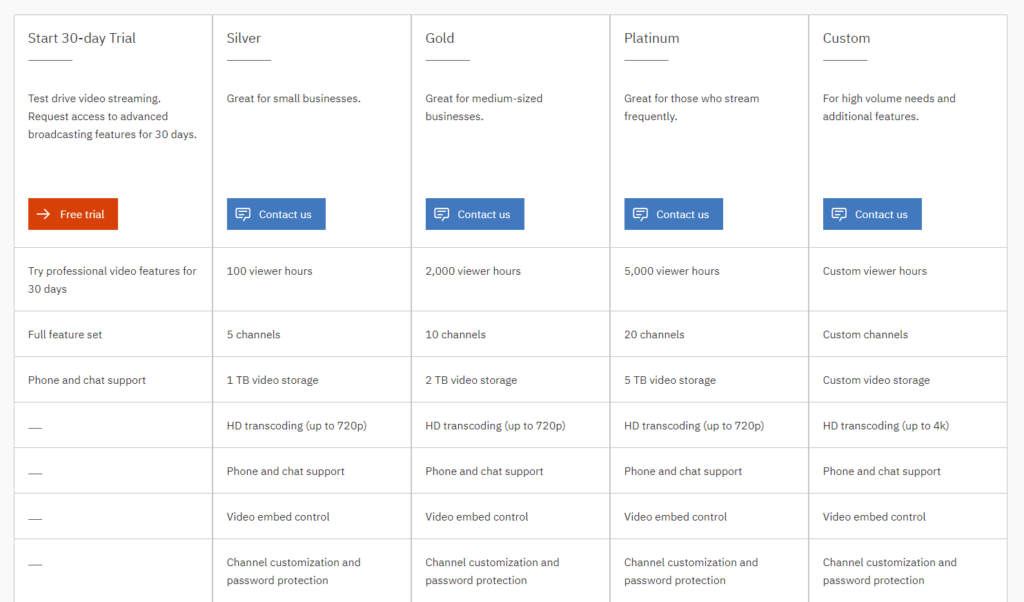
12. Setplex
| Monetization Model | Key Monetization Features | Pricing | Free Trial |
|---|---|---|---|
| AVOD | IPTV and OTT monetization SCTE 30 ad serving Server-side ad insertion Detailed ad analytics |
N/A | No |
Setplex is an OTT and IPTV platform designed for publishers who want to start an online or satellite streaming platform. It uses global CDN technology and top-tier security solutions ideal for broadcasters who want to offer a high-quality service.
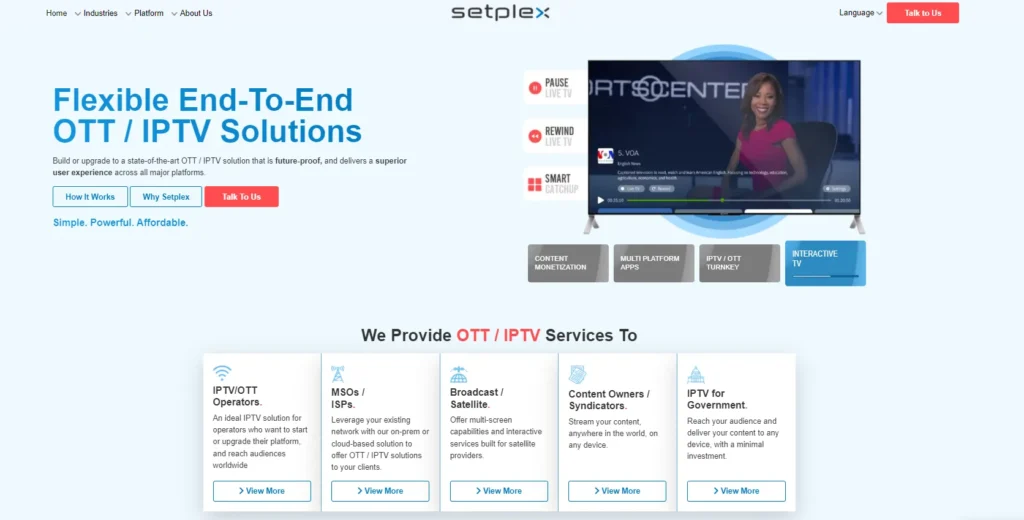
Monetization Overview
Setplex allows publishers to monetize live and on-demand content through advertisements. The platform’s advertising solution comes with server-side ad insertion, SCTE 35 support, and AI technology. Powerful, detailed ad analytics are also available. Although the platform doesn’t support SVOD monetization, it allows for an AVOD/SVOD hybrid model through third-party integrations.
Pros:
- All-in-one OTT and IPTV support
- High-end security solutions
- Extensive AVOD support
- Reliable multi-CDN infrastructure
Cons:
- No SVOD or TVOD monetization
- Non-transparent pricing system
- Charges onboarding fees
- No SDKs available
Pricing Overview
The cost of Setplex’s solutions is not publicly available, so those interested in partnering with them will have to get in touch with their sales team.
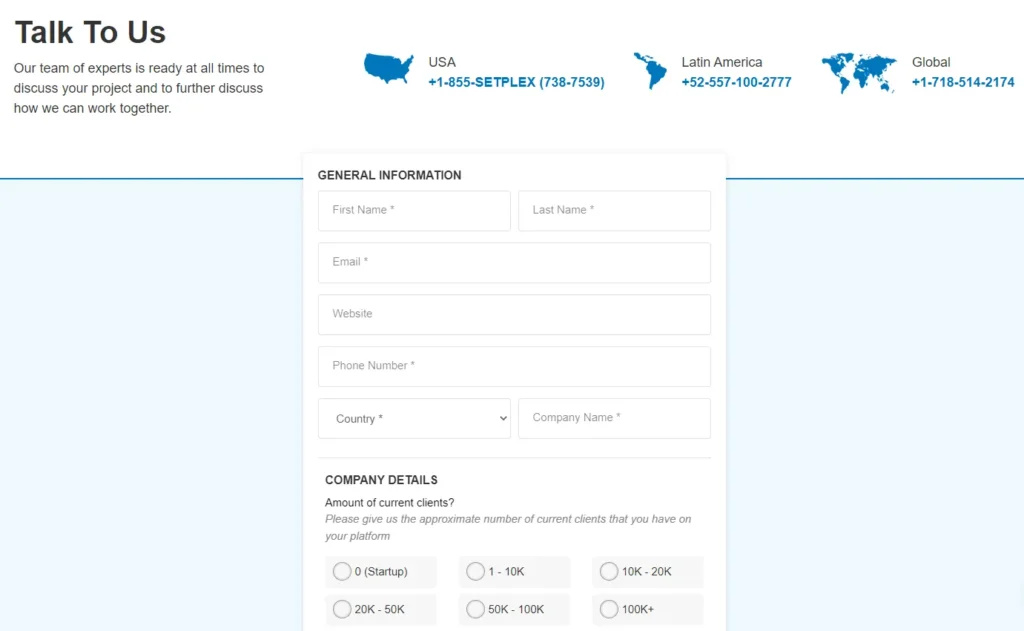
So Which Video Monetization Platform Is the Best?
Your choice of the right platform for your business will largely depend on the monetization method you pick. Here are our recommendations on the best platforms depending on your monetization model:
- Best SVOD platforms: Uscreen, Muvi, Dacast
- Best TVOD platforms: Brightcove, IBM Cloud Video, Uscreen
- Best AVOD platforms: Brid.TV, Brightcove, Dacast
If you want to start with ad-based monetization, why not partner up with Brid.TV? Our platform will allow you to serve well-targeted, effective, and high-quality video ads to your audience and generate income with little effort. What’s more, we also offer a premium free trial. Join our platform today to start monetizing!
FAQ
1. How to monetize videos?
You can monetize videos by serving advertisements, setting up subscription plans, or charging individual fees for access to content. These three main monetization models are known in the industry as AVOD, SVOD, and TVOD.
2. What’s the best video ad monetization platform for publishers?
Some of the best video ad monetization platforms for publishers include Brid.TV, Brightcove, and Dacast.
3. What is the best membership platform for creators?
The best membership platforms for creators include Uscreen, Muvi, and Dacast.
4. What’s the best OTT monetization platform?
The best OTT monetization platforms on the market include Brid.TV, Uscreen, and Muvi.
5. What’s the best live stream monetization platform?
The best live stream monetization platforms are CONTUS VPlayed, Brightcove, and Dacast.
